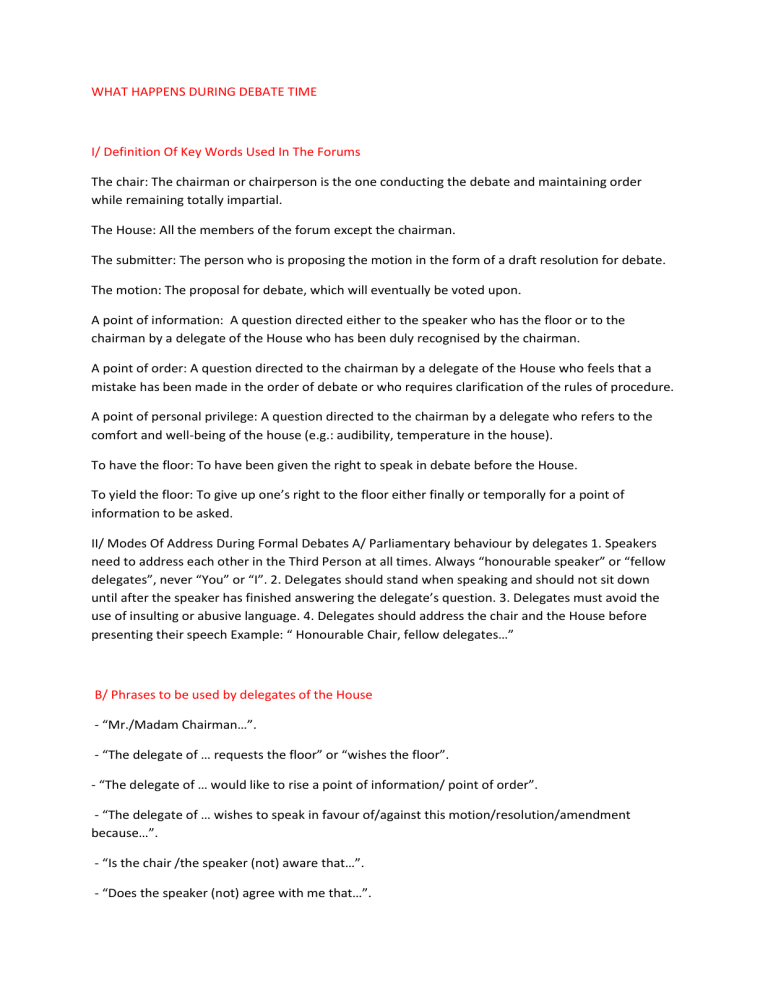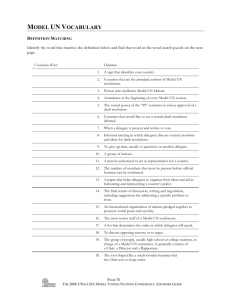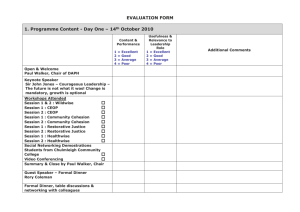
WHAT HAPPENS DURING DEBATE TIME I/ Definition Of Key Words Used In The Forums The chair: The chairman or chairperson is the one conducting the debate and maintaining order while remaining totally impartial. The House: All the members of the forum except the chairman. The submitter: The person who is proposing the motion in the form of a draft resolution for debate. The motion: The proposal for debate, which will eventually be voted upon. A point of information: A question directed either to the speaker who has the floor or to the chairman by a delegate of the House who has been duly recognised by the chairman. A point of order: A question directed to the chairman by a delegate of the House who feels that a mistake has been made in the order of debate or who requires clarification of the rules of procedure. A point of personal privilege: A question directed to the chairman by a delegate who refers to the comfort and well-being of the house (e.g.: audibility, temperature in the house). To have the floor: To have been given the right to speak in debate before the House. To yield the floor: To give up one’s right to the floor either finally or temporally for a point of information to be asked. II/ Modes Of Address During Formal Debates A/ Parliamentary behaviour by delegates 1. Speakers need to address each other in the Third Person at all times. Always “honourable speaker” or “fellow delegates”, never “You” or “I”. 2. Delegates should stand when speaking and should not sit down until after the speaker has finished answering the delegate’s question. 3. Delegates must avoid the use of insulting or abusive language. 4. Delegates should address the chair and the House before presenting their speech Example: “ Honourable Chair, fellow delegates…” B/ Phrases to be used by delegates of the House - “Mr./Madam Chairman…”. - “The delegate of … requests the floor” or “wishes the floor”. - “The delegate of … would like to rise a point of information/ point of order”. - “The delegate of … wishes to speak in favour of/against this motion/resolution/amendment because…”. - “Is the chair /the speaker (not) aware that…”. - “Does the speaker (not) agree with me that…”. - “The speaker stated in his/her speech… Doe he/she (not) realize that…”. - “The delegate of … moves to amend the resolution by striking/inserting/adding the words…”. - “The delegate of … urges the House to give its support by voting for/against this motion/resolution/amendment”. C/ Phrases to be used by the chairman – “The House will come to order” or “Will the house please come to order”. - “The chair calls upon the delegate of … (the submitter) to read the resolution to the House”. - “The House has heard the resolution. Is there a second?”. - “The chair fixes a debate time of 10 minutes for and 10 minutes against the motion”. - “The delegate of … has the floor”. - “All points are out of order until the speaker has concluded his/her speech”. - “The chair recognizes the delegate of…”. - “To what point does the delegate of … rise?”. - “Please rise and state you point of information/point of order”. - “Will you please state your point in a form of a question”. - “The speaker appears not to have heard/understood your question”. - “Will you please repeat/rephrase your question”. - “Are there any further points on the floor?”. - “Are there any further points of information to this speaker?”. - “There is a point of order on the floor. Please rise and state your point”. - “Your point is (not) well taken”. - “Will the speaker please make his/her concluding remarks”. - “Debate time for/against the resolution/the amendment has been exhausted/has expired. Will the speaker please yield the floor”. - “The chair proposes an extension of debate time by 5 minutes for and 5 minutes against the motion”. - “The debate is now closed. We will moved into voting procedures”. - “All points are out of order”. “The motion will now be put to the vote”. - “Will all those in favour of the resolution/the amendment, please raise their placards”. - “Will all those opposed to against/against the resolution, please raise their placards”. - “Will all those abstaining, please raise their placards” . - “The motion/the resolution/the amendment has passed by…”. - “The motion/the resolution/the amendment has failed by…”. - “With x votes in favour, y votes against and z votes abstaining, the motion/the resolution/the amendment has passed/failed”. - “Clapping is (not) in order”.


